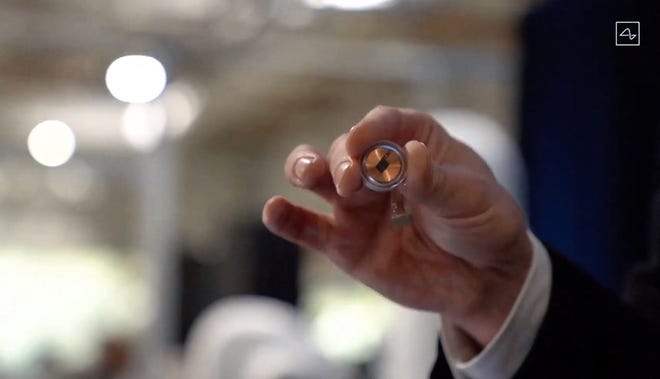Musk’s Neuralink implants first affected person. It is a part of a protracted legacy.
On Tuesday, Elon Musk’s Neuralink firm introduced it had implanted the primary affected person with its mind chip know-how. The work builds on many years of analysis from tutorial labs and different firms, connecting human brains to computer systems to handle human illnesses and disabilities.
The primary paralyzed affected person was implanted with a so-called brain-computer interface round 2006 by way of an organization referred to as Cyberkinetics based out of Brown College. Among the researchers concerned in that effort are actually working with Musk at Neuralink.
Extra just lately, brain-computer interfaces have helped paralyzed folks stroll once more, begun restoring contact and speech, and helped folks with different motion issues, resembling stroke, Parkinson’s and ALS. They’ve additionally been used to deal with mind issues, together with melancholy, dependancy, obsessive-compulsive dysfunction and traumatic mind accidents.
Most of the brain-computer interfaces write alerts into the mind by way of electrical stimulation. Different interfaces are positioned into the mind to “learn” the voltage put out by firing mind cells.

How does the Neuralink implant work?
The Neuralink gadget data exercise from electrodes positioned subsequent to particular person mind cells making it attainable to learn out the individual’s supposed actions.
The corporate has stated it’s on the lookout for volunteers to take part who’ve restricted perform in all 4 limbs as a consequence of ALS (amyotrophic lateral sclerosis) or have had a spinal twine damage not less than a 12 months in the past from which they haven’t considerably recovered. Volunteers have to be keen to permit the corporate’s R1 Robotic to surgically place an implant in a area of their mind that controls their physique’s supposed motion. They need to additionally comply with take part in six years of coaching and follow-up classes.
The Musk invention would not get an individual transferring. For that, there must be a second intervention.
To revive motion for an individual whose limbs do not transfer, the microelectrodes that “learn” mind alerts need to be linked through a “digital bridge” to the spinal twine which then stimulates motion, stated Grégoire Courtine, a Swiss neuroscientist who works within the space and helped co-found an organization Onward Medical to commercialize the work.

“Presently, Neuralink has solely implanted a chip within the mind,” he stated through e-mail. “Now we have already linked our neurostimulation platform with (a brain-computer interface) gadget to revive motion after paralysis. We welcome the chance to do the identical with the Neuralink gadget.”
Different mind applied sciences
Different firms and researchers are working with related units in addition to with units that learn from giant populations of mind cells, which can be utilized, as an illustration, to decode the silent speech the folks use in their very own heads, stated Richard Andersen, a neuroscientist at Caltech, who’s doing this work. This might allow individuals who cannot converse in any respect to have the ability to articulate their ideas, he stated.
Andersen, a professor of Biology and Organic Engineering, can be utilizing ultrasound know-how to learn mind exercise utilizing much less invasive know-how. With this type of gadget, a “window” would have to be put in into the cranium, permitting ultrasound waves to go into the mind, however electrodes wouldn’t have to be exactly positioned deep contained in the mind as with different units, he stated.

Units referred to as deep-brain stimulators have lengthy handled situations like Parkinson’s illness, epilepsy and important tremors, offering particular stimulation. Extra just lately, they’ve listened to the mind to know when these stimulations are wanted, stated Dr. Brian Lee, a purposeful neurosurgeon on the College of Southern California.
Mind-computer interfaces, like Musk’s Neuralink’s in contrast, can pull out alerts and have a lot broader potential, Lee stated.
It is nonetheless too early to say what the complete potential of Neuralink can be, he stated.
“Up to now he hasn’t proven us something but,” Lee stated. “Presumably, he’ll be capable of use these alerts as different labs have, to manage a cursor on a display screen, perhaps to decode spech, perhaps to maneuver a wheelchair round. He hasn’t proven us what he can do with this know-how but.”
Andersen stated his group and others are actually utilizing related units to Neuralink’s, however with a lot smaller stimulating electrodes, to revive the sense of contact to folks with paralysis and lack of contact sensation.
Finally, he stated, the identical gadget used to assist learn a paralyzed individual’s intent to maneuver may assist the individual sense an object, so they may, for instance, choose up a can of soda with out crushing it and convey it to their mouth to take a sip.
Andersen stated he hopes merchandise like this can be commercially accessible for folks with paralysis within the not-too-distant future.
“That will be the aim for many people (within the subject),” he stated, with different medical makes use of to comply with. “Neurotech extra broadly is a quickly accelerating space.”
